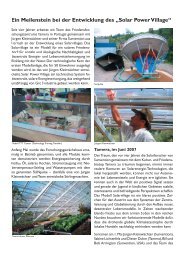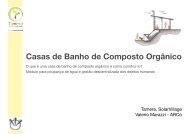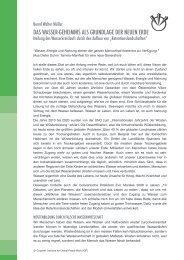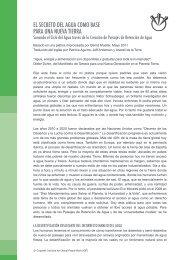You also want an ePaper? Increase the reach of your titles
YUMPU automatically turns print PDFs into web optimized ePapers that Google loves.
and fewer and fewer plant and animal species can survive. Soil dryness and the loss of<br />
biodiversity are the most important indicators of desertification.<br />
The water table is falling – worldwide and dramatically so. The global supply of drinking<br />
water is diminishing. Here we face the actuality directly leading us to apocalyptic scenarios<br />
if we do not manage to halt this process. Due to the falling water table, counter pressure<br />
can no longer be built up in the ground, salt water infiltrates unhindered deep into the land,<br />
and the soil and deeper lying freshwater reserves become saline. The ecosystem collapses<br />
– an almost irreversible situation. In many coastal areas worldwide this process is already<br />
happening. Also here in the Iberian peninsula many bore-holes and wells in the coastal areas<br />
have already become saline. But what kind of times does humanity approach if there is no<br />
more drinking water? Here we may not turn away and allow something to happen that could<br />
be prevented. The knowledge for this is available; now it is about applying it. We know: This<br />
is not how planet Earth is meant to be. This is not how the coexistence of humans, animals<br />
and Earth is meant to be. This is not how life is meant to be.<br />
THE LARGE WATER CYCLE<br />
Let us look again at the healthy picture – it is the picture of the large (or ‘full’) water cycle.<br />
The rain that falls on the earth is absorbed by a layer of humus that soaks it up like a<br />
sponge. Not long ago on the land of <strong>Tamera</strong> there was a living fertile soil layer of up to half<br />
a metre in depth. It was more or less like this over the whole of Portugal and in principle<br />
across the whole of Europe. This humus soil layer, which was shaded and rooted by plants,<br />
soaked up the rainwater and thus gave the water time to seep into the deeper ground layers<br />
and fill up the earth-body. In this way a saturated earth-body acted as a storage organ.<br />
There, underground, the water rests at different depths, sometimes over long periods of<br />
time. We still know little about what really happens to the water down there in the darkness.<br />
I feel this as the ‘female’ or ‘soul’ part of the water cycle. What we can say is that the water<br />
matures there by mineralising itself and taking on information. This ability to take on and<br />
store information is one of the essential and most mysterious qualities of water.<br />
At different depths in the saturated earth the water cools down differently. Where it is the<br />
coldest it rises back to the surface as mature spring-water. Spring-water has a great healing<br />
power for the Earth and all her creatures. Streams and rivers flowing with spring-water that<br />
are allowed to meander in accordance with their beings have healing power for the land. The<br />
water vitalises itself increasingly over the course of its flow. On the banks of such streams<br />
and rivers, diverse habitats develop where life unfolds itself.<br />
The water in the large water cycle is flowing continuously and steadily. The earth acts as<br />
a buffer, as it can absorb a large amount of water at once but releases it only slowly. In<br />
this way floods are prevented, and at the same time the streams carry water all year long.<br />
The balance is reached between the rainy winter months and the dry summer. This applies<br />
in principle throughout all climate zones. A large water cycle in which the earth-body<br />
completely fulfils its function once again creates stability and equilibrium everywhere.<br />
HEALING NATURE THROUGH WATER RETENTION LANDSCAPES<br />
Today the earth-body, the humus topsoil, has disappeared from a large percentage of the<br />
Earth’s surface. The erosion process, especially over the last decade, has progressed so<br />
rapidly and extensively that one can speak of a global disaster. This is why we must not<br />
delay ourselves by developing ecosystems which create a thin layer of humus only after<br />
thirty, forty or even more years. We need this balancing sponge-effect sooner. In order to<br />
©<br />
Copyleft: Institute for Global Peace Work (IGP)











